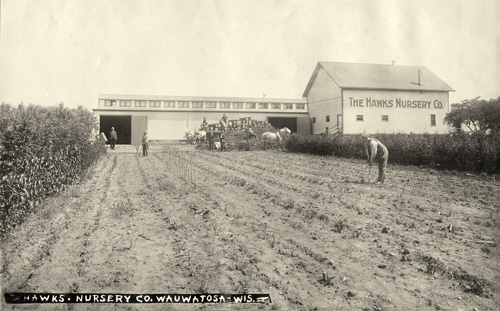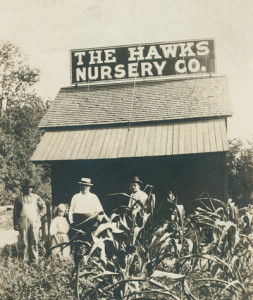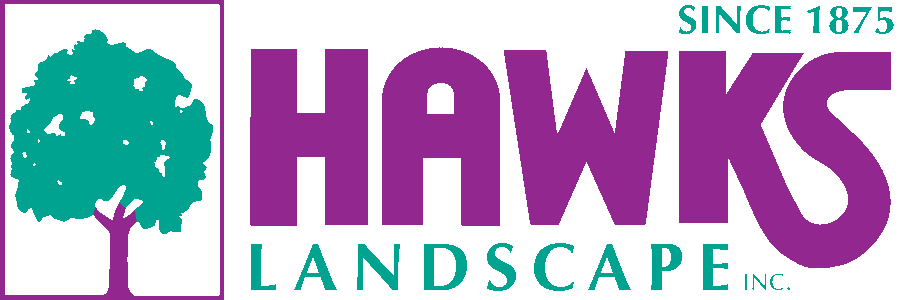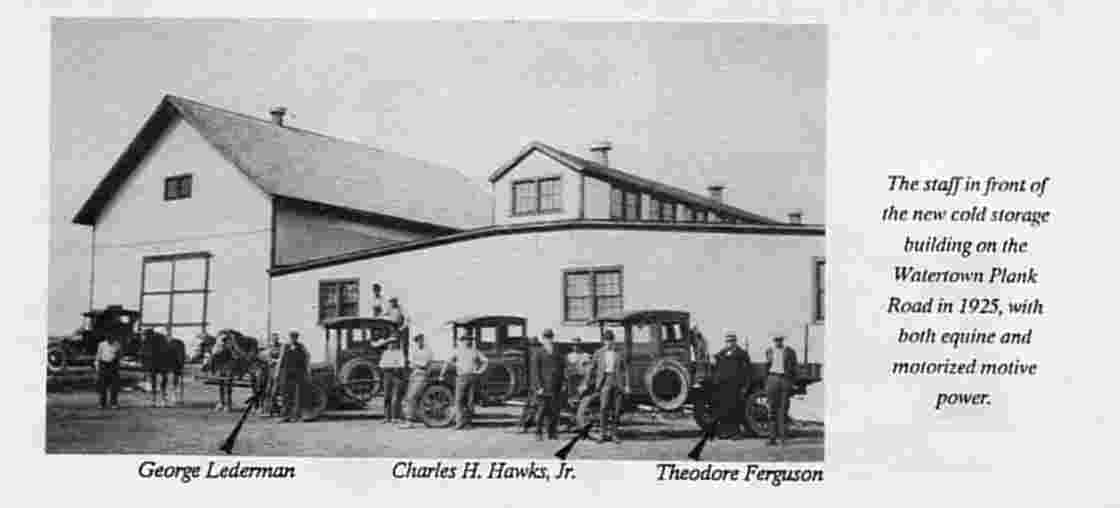Wauwatosa Historical Society
Hawks Nursery: reprint of Historic Wauwatosa
By George Wells Number 75 March 1990
America had started a great period of growth in the last quarter of the 19th century. Wauwatosa’s Hawks Nursery Company is a part of that era. The Civil War had ended, the industrial revolution was in full bloom creating a prosperous middle class. Fueling the economic growth were the waves of immigration from Europe reaching the shores of America, helping the great westward expansion of our country. The wealthy class of the Eastern seaboard had built mansions and great estates using their own gardeners and landscapers emulating the lifestyles of the wealthy Europeans. The expanding middle class wanted to copy this lifestyle, creating a large demand for trees. shrubs and plants to complement the Victorian houses being built and also to landscape the myriad new cities which were being established.
To fill this great demand for plant material, a whole new industry was born in upstate New York. That area, with its fertile soil, good moisture and climate was ideal for the landscape business. The nation’s developing rail system allowed plants to be shipped to the many developing markets. One of these new nurseries was the Hawks Nursery Company, founded in Rochester, New York in 1875 by Charles H. Hawks Sr., Arthur H. Moser and Theodore J. Ferguson.
Shortly after the nursery was founded, Ferguson, who had roots in Wauwatosa, as well as Rochester, opened a branch of the nursery here. The 1893 Milwaukee city Directory shows Ferguson having offices 70 Loan and Trust Building. The offices moved to several other locations and were last reported in 1900 at 106 E. Mason Street in downtown Milwaukee. As a 1976 Tosa Post-News article stated, ” This was not exactly your ten minute express ride between offices”. However, at that time, nurseries had salesman who traversed the country by horse and buggy or rail, visiting their customers once or twice a year. The early Hawks business dealt largely in fruit trees and shade trees, serving the needs both of farmers and the new cities west of the Appalachian Mountains. Orders were filled with trees grown in New York and then shipped to the more western states as well as the natural markets surrounding Rochester. By the late 1800’s more than 200 salesmen were representing the Hawks Nursery Company and the business continued to grow.

We do not know the exact date when the company headquarters was moved to Wauwatosa. Ferguson was here; Hawks Sr. and Moser were still in Rochester, but orders from this part of the country began to predominate. Ed Wilkomen has found from records that Hawks Nursery Company rented land from Jacob Wellaur at 59TH Street and Grand Ave in the 1890’s. [See Figure 1 map.] Even now, a visitor to this area can see backyards with rows of trees which must have been planted by the nursery.
Wilkomen also found a map, in the city plat books, which shows that Hawks Nursery Company had bought land from J. D. Gilbert, who was a major Wauwatosa landowner. This was a 20 acre “L” shaped parcel of land abutting North Avenue and Swan Boulevard (Figure 2). This land was also used for growing stock.
Wilkomen’s research led to records, dated July 15, 1910, indicating that work had begun on the Hemsing Building on state and Harwood and that on July 28, 1911, Hawks Nursery Company rented rooms on the second floor of the Hemsing Block and occupied those rooms after Aug. 1, 1911.
Use of the Wellauer property ceased and nursery operations were concentrated on the Swan – North Avenue Property. Theodore Ferguson was living in the area of Lovers Lane (HWY 100) north of Burleigh and his property was also used for growing nursery stock. During the period from the turn of the century to the 1920’s, we know the company sold extensively to municipalities through it’s wide-ranging salesmen and rail shipping programs.
The 1905 Wauwatosa City Directory shows that Ferguson lived at 405 Second Avenue. His house was directly across the street from the Kneeland-Walker mansion, on the south-west corner of 74th Street and Hillcrest Drive. This Property became a part of the Kearney estate. It is possible that Mr. Kneeland , who had built his mansion at Center Street and 2nd Avenue, purchased the specimen maple trees currently on the property from Hawks. We do know from local records that on Sept 6, 1912, Hawks formed a real estate company. On Aug. 28, 1914, the Hawks Nursery (Realty) Company sold a lot on the southeast corner of 2nd Avenue and Center Street (now 74th and Hillcrest) to Minard Tilgren. This is diagonally across the street from the Kneeland-Walker House. Tilgren was a famous local architect who built the poured concrete house still standing at this location and still admired for its unique architecture.
Charles Hawks, Jr. was born in Rochester New York. In 1916, he graduated from the University of Rochester and took a job with his father’s company, supervising shipping operations. He joined the U.S. Army upon America’s entry into World War I and rejoined the business after his army service.
 A great deal happened to the company at this time. Mr. Moser died and the Hawks family purchased his interest. Hawks, Jr. moved to Wauwatosa and the offices were moved one door east on State Street to the second floor of what is now the Chancery Restaurant. Arthur Kohasky, former chairman of the board and president of the Wauwatosa State Bank (now M&I Wauwatosa State Bank) recalls that when the bank opened for business on July 31, 1921 on the first floor of this building, that Hawks Nursery occupied a suite of offices on the second floor, overlooking the Menomonee river.
A great deal happened to the company at this time. Mr. Moser died and the Hawks family purchased his interest. Hawks, Jr. moved to Wauwatosa and the offices were moved one door east on State Street to the second floor of what is now the Chancery Restaurant. Arthur Kohasky, former chairman of the board and president of the Wauwatosa State Bank (now M&I Wauwatosa State Bank) recalls that when the bank opened for business on July 31, 1921 on the first floor of this building, that Hawks Nursery occupied a suite of offices on the second floor, overlooking the Menomonee river.
Mr. Kohasky, just starting at the bank, became good friends with the upstairs occupants. He recalls that he and Charlie Jr. played on the Hawks Nursery team in the local Wauwatosa basketball league which was in existence at that time. Kohasky is much too modest to brag now of their victories, but does admit the team was “one to contend with”. There were no restaurants in the village area at that time, so he and Charlie often took their noon meal at Annie Wells’ Rooming and Boarding House, 1218 Glenview. It was here that Charlie met his wife, Alice Hammond, who roomed and boarded there. They were married in 1925 and had two sons, Charles Hawks III and Graham Hawks.
In September, 1925, Theodore Ferguson sold his interest in the company. Upon Ferguson’s retirement, he was quoted in a local news article: “I cannot praise too highly Wisconsin’s soil and climate. In my estimation there is no better farming land in the world than that close around Milwaukee. As for climate, I find it most suitable for general nursery work. The winters are perhaps too cold for the successful raising of seedlings and for certain other usual southern stock, but for all else, it is unequaled, having at the same time the advantage of a suitable climate for evergreens.”
In June 1927 the Swan-North Avenue property was sold and the land subdivided by Hawks, Sr., Hawks, Jr., and A.W. Ritter. On September 2, 1927 and again in November of 1928 the company purchased a total of 38 acres of land from W.S. Robbins at 122nd street and Watertown Plank Road in the Town of Wauwatosa. This is the location of the nursery to this day. (See drawing) The cold storage shed on the North Avenue property was dismantled and the beams were used to erect a new shed adjacent to the existing barn at the Plank Road property. (See photo) The property extended from Watertown Plank to Underwood Creek. Along with the storage shed, a large barn existed on the property which housed horses which were used to till the fields. A pet goat supplied milk to George Lederman, the company foreman.

Charles Hawks III, a retired executive of Westinghouse Electric Company, who now lives in Indianapolis, recalls that he, his brother, and their friends spent time at the nursery as children. His grandfather, Charles Sr., moved to Wauwatosa in 1925 and lived here until his death in 1935 at age 85. He would go to the nursery with his grandchildren. Charles III remembers being awakened one night in the early ‘30s by a phone call informing his father that the barn in the nursery had caught fire. The family drove out the Plank Road and at the hill on 90th Street, at the County Institution, they could see the sky filled with flames of the fire. Fortunately, the neighbor who lived just west of the nursery had seen the fire in it’s early stages, called the fire department and was able to lead the horses and the foreman’s goat to safety. The barn was never rebuilt; stalls were built in the west end of the cold storage building to house the animals.
 Charles III tells that the horses were used not only to till the nursery lot, but were also hitched to wagons which hauled the nursery stock to the railroad station in Elm Grove for shipping throughout the country. He and his brother, Graham, a history professor at Western Michigan University, recall trips by automobile, as children, with their parents. Ostensibly, the purpose of the trips was to see the sights of America or to visit relatives. If their route led through Muskegon, Michigan or Omaha, Nebraska, their father might turn off the highway and drive through the city streets to show the boys elm trees grown at Hawks Nursery, sold by salesmen, and shipped by rail, to landscape America.
Charles III tells that the horses were used not only to till the nursery lot, but were also hitched to wagons which hauled the nursery stock to the railroad station in Elm Grove for shipping throughout the country. He and his brother, Graham, a history professor at Western Michigan University, recall trips by automobile, as children, with their parents. Ostensibly, the purpose of the trips was to see the sights of America or to visit relatives. If their route led through Muskegon, Michigan or Omaha, Nebraska, their father might turn off the highway and drive through the city streets to show the boys elm trees grown at Hawks Nursery, sold by salesmen, and shipped by rail, to landscape America.
A.C. Hanson Joined the company in 1926 as vice-president and became president in the mid 1930’s. At that time he was also mayor of Wauwatosa. The depression of the ‘30s changed the business. Cities had stopped growing; the sales force could no longer obtain the orders needed to keep the large operation going. Orders from farmers for fruit trees were also fewer. It was at this time that Hawks turned to ornamental landscaping for homeowners and businesses, for which it is famous today.
Charles Jr., in the ‘30s, felt “we are all going to wind up in the poor house”, but the nursery operation had fringe benefits which other businesses did not have. “The satisfaction of working outdoors and eating a sandwich on a summer day in the shade of a huge Carolina poplar was enough for many to counterbalance the lower wages paid”.
 He described the water for drinking, which came from the well, as unequaled anywhere and none ever tasted better. The outhouse, he remembered was supplied with “catalogues and wasps nests.” In an interview, he recalled the storage shed or “The Shed”, with its louvres in the ceiling to let in the cool night air and let out the heat of the day, “was always enclosed in a unique mixture of smells which varied with the seasons. In the early spring, when the mornings were still quite cold, the smell of two or three horses stabled in the shed (Tom, Maude, Belle) was almost overpowering before the stalls were cleaned.” But deeper in the shed, “sphagnum moss, shingletoe, peat moss and oakum combined to produce the most beautiful deep woods odor.”
He described the water for drinking, which came from the well, as unequaled anywhere and none ever tasted better. The outhouse, he remembered was supplied with “catalogues and wasps nests.” In an interview, he recalled the storage shed or “The Shed”, with its louvres in the ceiling to let in the cool night air and let out the heat of the day, “was always enclosed in a unique mixture of smells which varied with the seasons. In the early spring, when the mornings were still quite cold, the smell of two or three horses stabled in the shed (Tom, Maude, Belle) was almost overpowering before the stalls were cleaned.” But deeper in the shed, “sphagnum moss, shingletoe, peat moss and oakum combined to produce the most beautiful deep woods odor.”
After World War II, Hawks had to decide whether to sell the land or to look for new, well-trained men to help him. In 1950, after graduating with a degree in horticulture from the University of Wisconsin – Madison, John Orton joined Hawks Nursery. At that time, the mechanical equipment consisted of one tiller and two old trucks. In October, 1951 the State Street office was closed and a new office was built on the nursery property. In 1955, Jim Bennett, also a UW – Madison horticulture graduate, joined the company. New blood and new ideas brought great changes to the business. Land was sold in 1956 and the 38 acres were reduced to the existing 10 acres. In 1969, another corporation, Hawks Landscaping Inc. was formed to perform the union contracts while allowing Hawks Nursery to do the non-union work. In 1972, Charles Hawks, Jr. sold his interest to John and Jim.
He and his wife, Alice, continued to live in Wauwatosa. Charlie never really left the business. He continued to go out to the nursery until he and Alice moved to a retirement community in Kalamazoo, Michigan in the mid ‘70s, to be near their children. Charles Jr. died in November, 1984 and Alice Hawks in December, 1989.
Under John Orton and Jim Bennett, the nursery continued its strong tradition, doing both large commercial jobs, such as the landscaping of Northridge, Southridge and Brookfield Square shopping centers, as well as many fine residences in southeastern Wisconsin.
Today there are about 20 vehicles, six loaders two backhoes, two tractors, 18 trailers and innumerable small pieces of power equipment. In the mid ‘70s, Hawks removed the field-grown stock from the front of the property and established a retail garden center on the 650 foot frontage on Watertown plank road. The operations now employ 60 people.
With its roots dating back to the establishment of the landscaping business in this country, and with its history being so much a part of Wauwatosa, we can be very proud of this company, wishing it success in the future.
Update: On November 12, 1993, Joseph Kresl purchased Hawks Nursery. Work on a new garden center building began in December of 1993. The new, state of the art garden center was completed and open for business on April 15th, 1994. The construction offices, vehicle maintenance facility, stock room, and design/build offices were completed between 1994 and 2000, the 125th anniversary of the company. Today, Hawks employs around 150 people at the peak of the season.


